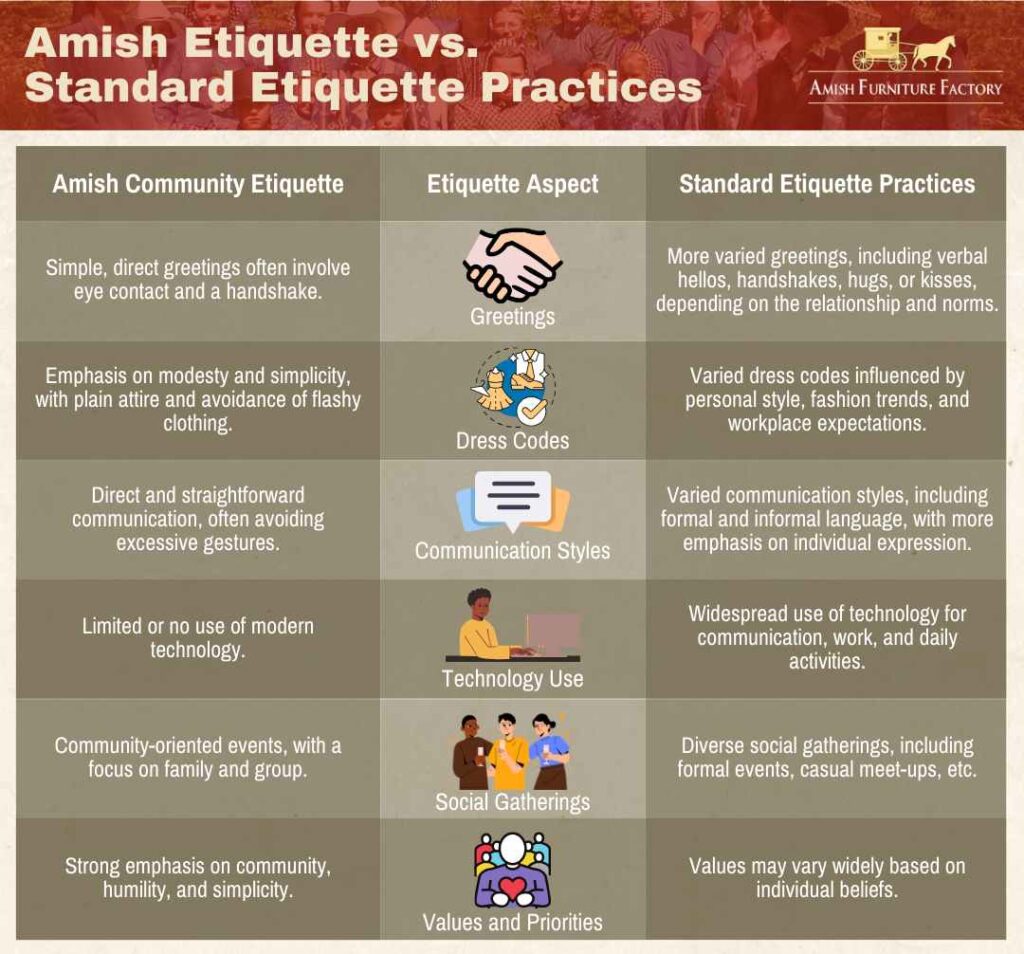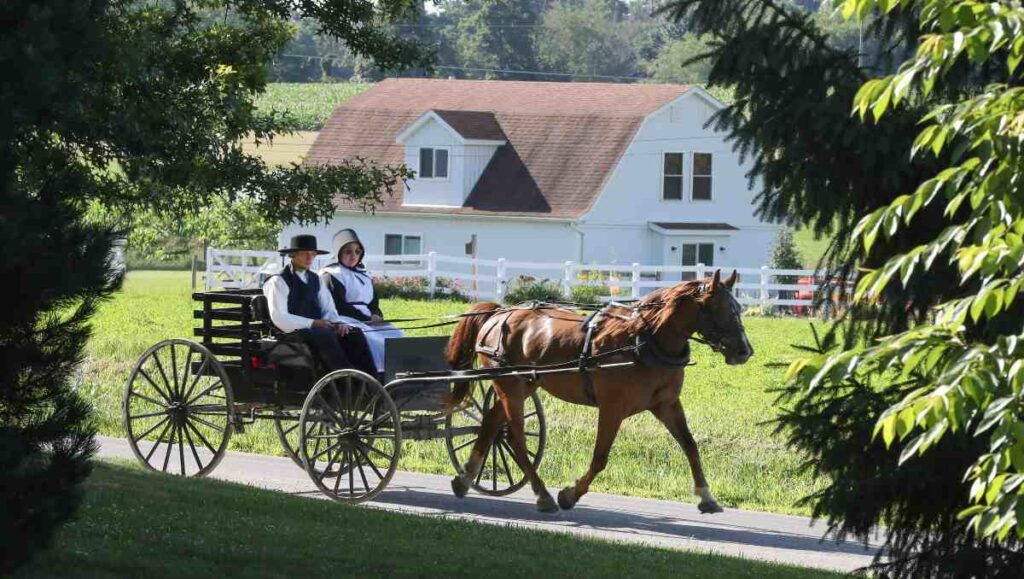
When you step into the world of the Amish, a captivating tapestry of customs and traditions awaits. Understanding and respecting their unique etiquette is essential for forging meaningful connections as you navigate their society. What exactly is the Amish etiquette?
Amish etiquette emphasizes humility, respect, and adherence to community norms. Common practices include plain dressing and strongly emphasizing family and community unity.
This article will delve into the fascinating world of Amish etiquette. We will debunk common myths and stereotypes while providing tips for outsiders who wish to interact respectfully with this remarkable community.
Core Values Shaping Amish Etiquette
In Amish etiquette, there’s a strong emphasis on humility and simplicity. This means that individuals are expected to prioritize modesty in their appearance, actions, and interactions with others.
Emphasis on Humility and Simplicity
Humility and simplicity are deeply ingrained in the Amish culture and heavily influence their social customs and etiquette practices. Humility is at the forefront of their interactions, promoting respect for others and discouraging arrogance. It is reflected in their modest clothing choices, simple lifestyles, and humble attitudes.
Simplicity also plays a significant role in shaping their etiquette norms. The Amish believe material possessions can distract from spiritual growth, so they prioritize minimalism and frugality. This mindset extends to their interactions with others, where they strive for genuine connections rather than superficiality, transcending the emphasis on buying goods and shopping.
The Role of Community and Communal Living
The Amish value living in close-knit communities, as it brings numerous benefits. One of the main advantages is the readily available support system. In times of need or celebration, neighbors and friends are always there to lend a helping hand or share in the joyous moments.
Additionally, communal living allows for sharing resources such as tools, equipment, and even labor. This promotes efficiency and fosters a sense of unity among community members.
However, living in such a tight-knit community also has its challenges. Privacy can be difficult to maintain when everyone knows each other’s business. While this can create a strong sense of accountability within the community, it may also lead to feelings of intrusion or lack of personal space.
Connection Between Religious Beliefs and Everyday Etiquette Practices
The Amish community’s religious beliefs heavily influence their everyday practices, values, and communication guidelines. For the Amish, their faith is not just something they practice on Sundays; it permeates every aspect of their lives, including how they interact with others.
Their commitment to simplicity, humility, and selflessness is reflected in their etiquette practices. They prioritize communal living and emphasize the importance of putting others before themselves. This translates into polite and respectful behavior towards one another, such as using proper greetings, maintaining eye contact during conversations, and speaking kindly to each other.
Daily Life Etiquette
Regarding daily life etiquette in Amish communities, greetings and introductions are crucial. Knowing the proper way to greet someone and introduce yourself is important to show respect and maintain harmony within the community.
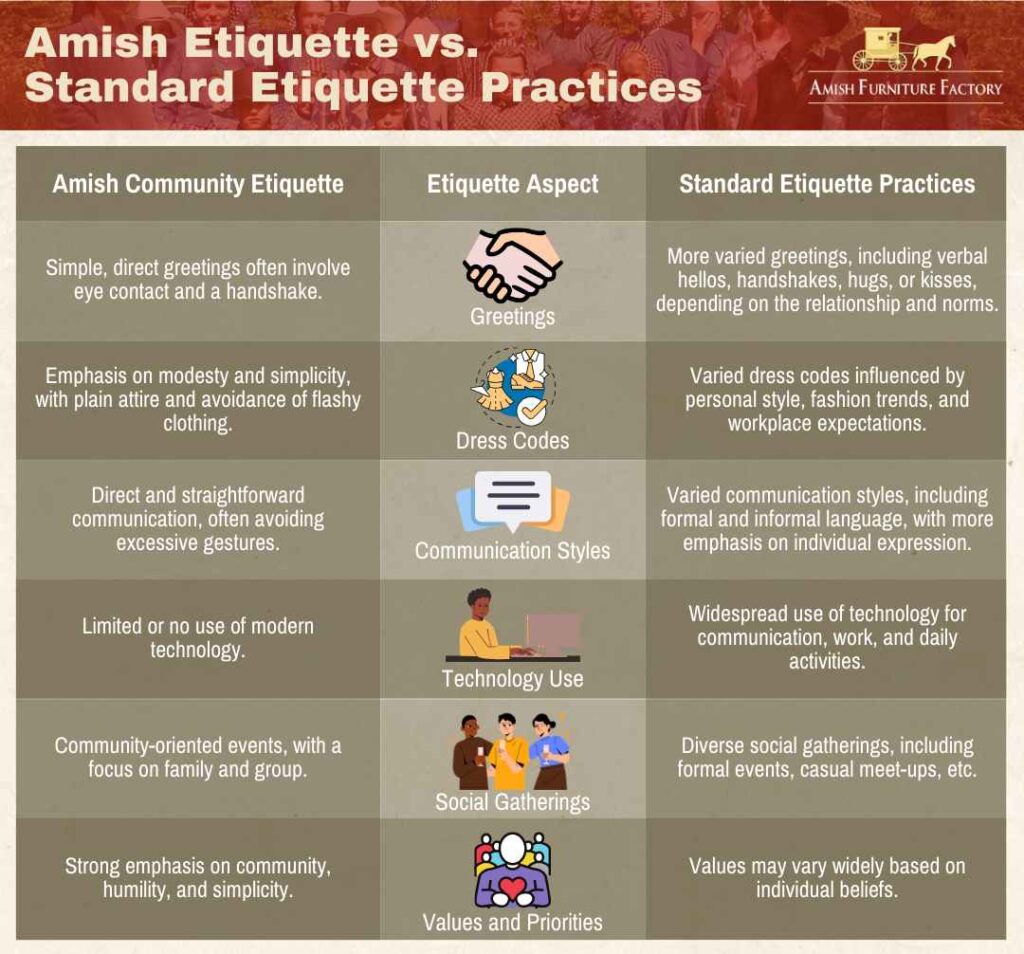
Greetings and Introductions in Amish Communities
To make a good impression in an Amish community, remember to offer a warm smile and a firm handshake when greeting someone. Greetings customs are important in Amish communities as they reflect social norms and communication etiquette.
When meeting someone for the first time, you must introduce yourself with your full name and ask for theirs in return. This helps foster a sense of community and establishes a personal connection. Additionally, addressing others respectfully using their first names shows proper etiquette.
In Amish communities, hospitality practices play a significant role in daily interactions. It’s common to invite guests into your home and offer them food or refreshments.
Guidelines for Communication Within the Community
Communication within the community is enhanced when individuals address each other respectfully using their first names. In Amish communities, specific communication norms are followed to ensure effective interaction.
Verbal and non-verbal cues play a significant role in conveying messages accurately. Maintaining eye contact, nodding, and using appropriate gestures are important aspects of non-verbal communication.
Respectful listening is highly valued, with individuals giving their undivided attention to the speaker and refraining from interrupting or speaking over others. Conflict resolution is approached calmly and rationally, emphasizing finding common ground and seeking reconciliation rather than confrontation.
Conversations tend to be more formal and reserved when it comes to communication in public settings, as individuals strive to uphold the values of modesty and humility that define Amish culture.
Interactions with Outsiders and the Concept of Hospitality
Interacting with those outside the community, Amish individuals warmly extend their hospitality, welcoming outsiders into their humble abode. The Amish understand and respect cultural differences, recognizing that visitors may come from diverse backgrounds.
Their hospitality customs reflect a desire to create an atmosphere of inclusivity and acceptance. When engaging in interfaith dialogue, the Amish approach conversations with an open mind and a willingness to listen and learn. They value respectful curiosity and understanding that asking questions can lead to a deeper understanding of one another’s beliefs and traditions.
By actively building relationships with outsiders, the Amish seek to bridge gaps between communities and foster connections based on mutual respect and shared values.
Family and Social Structure
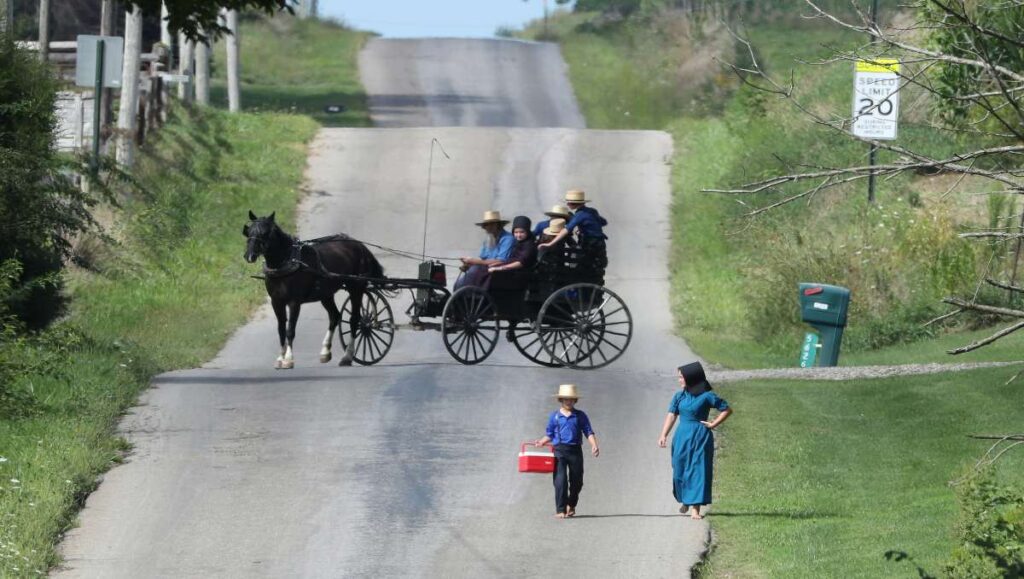
Regarding etiquette within Amish families, respect and humility are highly valued. Family members are expected to show deference to their elders and follow the guidance of community leaders.
Etiquette Within Amish Families
In Amish families, you’ll find that mealtime is a cherished tradition where everyone gathers together to enjoy delicious homemade food. Etiquette dynamics within these families emphasize respect and cooperation.
Parent-child interactions at the dinner table are characterized by parents serving their children first and encouraging polite conversation. Mealtime customs include saying grace before eating and waiting for everyone to be seated before starting the meal.
Household chores are shared among family members, with older siblings helping younger ones and adults assisting as needed. Social expectations dictate that children should be grateful for the meal by thanking their parents and contributing to the afterward clean-up.
This emphasis on etiquette strengthens family bonds and instills values of gratitude, respect, and responsibility in each member of the Amish community.
Community Events and Social Gatherings
Amish culture’s community events and social gatherings are filled with lively conversations, laughter, and a strong sense of togetherness. Social customs and cultural norms play a significant role in shaping the interaction etiquette during these gatherings.
At community events, such as barn raisings or weddings, it’s customary for everyone to participate actively in various tasks. Whether preparing food, setting up decorations, or assisting with chores, this collective effort fosters a sense of belonging and strengthens communal bonds.
During social gatherings, it’s expected that individuals engage in respectful and polite conversations. Personal topics such as gossip or controversial matters are generally avoided to prevent conflict or discomfort among attendees. Instead, conversations often revolve around shared experiences, family updates, and plans.
These social customs contribute to Amish gatherings’ warm and inviting atmosphere where individuals come together to celebrate their community ties while respecting each other’s boundaries.
Protocol for Addressing Elders and Community Leaders
Respect for elders and community leaders is the cornerstone of Amish social interactions, as they’re revered for their wisdom and guidance.
Addressing elders and community leaders in the Amish community requires respect and deference. When greeting an elder or a community leader, it’s important to use proper greetings, such as ‘Good morning’ or ‘Good evening,’ followed by their title, such as ‘Bishop’ or ‘Deacon.’
Maintaining eye contact during conversations shows attentiveness and respect. Additionally, using a gentle tone and speaking politely demonstrates deference towards elders and community leaders.
Religious Etiquette
Amish customs and religious practices are deeply intertwined with community dynamics, social norms, and cultural traditions. The Amish value simplicity, humility, and submission to God’s will in all aspects of their lives.
In religious etiquette, attending church services is paramount for the Amish. They gather in homes or barns every other Sunday to worship as a community. Men and women sit separately during these services, with married couples often divided. This seating arrangement reflects the traditional gender roles upheld by the Amish.
Amish attire also plays a significant role in religious etiquette. Men typically wear plain suits with suspenders and broad-brimmed hats, while women dress modestly in long dresses and aprons. These clothing choices reflect their commitment to simplicity and separation from worldly fashion trends.
Another crucial aspect of religious etiquette for the Amish is practicing nonresistance and forgiveness. They strive to resolve conflicts peacefully within their community and avoid seeking legal action whenever possible. This commitment to nonviolence extends even to self-defense situations.
Here’s a video explaining the basics of Amish church service customs and some things that make it different from other Christian churches.
Clothing and Appearance
When it comes to Amish clothing and appearance, understanding their dress codes and modesty is essential.
Amish Dress Codes and Modesty
To truly appreciate the rich Amish culture, you’ll love exploring their unique dress codes and embracing their commitment to modesty.
Amish fashion is deeply rooted in their religious beliefs and reflects their desire to separate themselves from the modern world. Traditional clothing plays a significant role in maintaining their identity and fostering a sense of unity within the community.
The Amish dress code emphasizes simplicity, practicality, and modesty above all else. Men typically wear plain trousers, suspenders, solid-colored shirts with buttons, and broad-brimmed hats. Women don long dresses with high necklines, covered shoulders, and aprons for added protection.
Etiquette Related to Grooming and Personal Appearance
Grooming etiquette is important to the Amish community as it reflects their commitment to simplicity and humility. Hygiene practices are highly valued, with regular washing a vital part of their daily routine.
Personal appearance standards emphasize clean and well-maintained appearances without excessive adornments or flashy accessories. Regarding hair care guidelines, men typically wear their hair short and neatly trimmed, while women keep their hair long and covered with a prayer cap or bonnet.
Skincare routines are simple yet effective, focusing on using natural remedies to keep the skin clean and moisturized.
Special Occasions and Celebrations
Regarding Amish weddings and marriage ceremonies, etiquette is an important aspect. The Amish community values simplicity and modesty, reflected in their wedding customs.
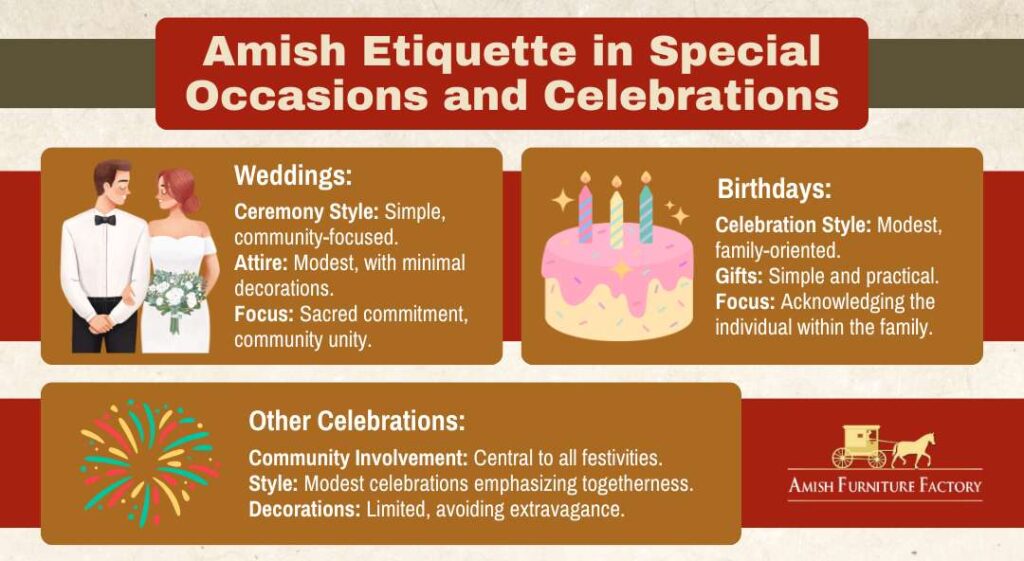
Etiquette During Weddings and Marriage Ceremonies
During Amish weddings and marriage ceremonies, it’s customary for you to abide by their strict etiquette guidelines.
Wedding traditions within the Amish community are deeply rooted in religious beliefs and cultural practices. Marriage customs are often simple and focused on the union of two individuals rather than extravagant celebrations.
When attending an Amish wedding, it is important to dress modestly, with women wearing long dresses and men wearing suits or traditional attire. Respectful behavior is crucial during these events, as they are significant for the couple and their families.
Bringing a gift that reflects practicality and simplicity, such as handmade items or homegrown produce, is customary. Additionally, photography or video recording may be prohibited during the ceremony, so respecting this request is essential.
Observing Birthdays, Holidays, and Other Special Events
Celebrating birthdays, holidays, and other special events is a time for gathering loved ones and creating cherished memories. In Amish culture, observing traditions and cultural practices during these occasions holds great significance.
Gift-giving etiquette among the Amish is often focused on practicality rather than extravagance. It’s common to give handmade items or useful tools that align with their simple way of life.
Religious ceremonies also play a central role in these events, with prayers and scripture readings incorporated into the celebrations.
Community events are also integral to observing birthdays and holidays within the Amish community. These gatherings provide opportunities for fellowship and strengthening bonds among community members.
Gift-Giving Traditions and Etiquette
Gift-giving in Amish culture is not merely an exchange of presents but a heartfelt expression of love and appreciation woven with the threads of tradition and shared values.
Giving gifts that reflect thoughtfulness and demonstrate an understanding of the recipient’s interests and needs is important. Handmade items are highly valued, representing the time, effort, and skill invested by the giver.
In terms of receiving gifts, demonstrating gratitude is essential. The Amish believe in showing humility and modesty when accepting gifts, reflecting their commitment to a simple way of life.
Etiquette in Business and Work

In the workplace, Amish individuals uphold a strict code of conduct that values simplicity, honesty, and respect. Formalities and a focus on efficient communication characterize business meetings among the Amish. They prioritize face-to-face interactions over electronic communication, such as emails or phone calls.
Professional behavior is highly valued, with punctuality being essential. Amish individuals believe in giving their full attention to the person they speak with, maintaining eye contact, and actively listening.
Office etiquette plays an important role in Amish work culture. Respect for authority figures is ingrained within them, and they demonstrate this by adhering to hierarchies within the workplace. They also emphasize maintaining a harmonious work environment through cooperation and teamwork.
Work-life balance is highly prioritized among the Amish. They believe in dedicating ample time to family and community outside work hours. This means that overtime or working long hours is uncommon among them.
Debunking Common Myths and Stereotypes About the Amish
When it comes to Amish etiquette, there are several common myths and stereotypes that need to be debunked.
Myth #1 – Amish people are overly strict and judgmental in their enforcement of etiquette.
There are many misconceptions about Amish traditions, but it’s important to understand the cultural diversity within Amish communities. Respect plays a crucial role in Amish etiquette and is highly valued among community members. However, this doesn’t mean that they’re rigid or unforgiving.
The Amish recognize the need to balance tradition and modernity in their communities, allowing for some flexibility when enforcing etiquette. Additionally, elders play a significant role in guiding and teaching others about proper behavior and manners. Their wisdom and experience contribute to maintaining the harmony within the community.
Myth #2 – Amish communities shun individuals who do not adhere strictly to their norms.
Contrary to preconceived notions, individuals who don’t strictly adhere to Amish norms aren’t automatically shunned by their communities.
While it’s true that the Amish strongly emphasize maintaining their traditions and way of life, they also recognize the importance of community integration and acceptance.
Social exclusion isn’t the immediate response to norm deviation within Amish communities. Instead, there is a level of acceptance and tolerance for those who may choose to deviate from certain norms.
It’s important to understand that cultural assimilation in the Amish context doesn’t mean complete conformity but finding a balance between personal beliefs and communal values.
Myth #3 – Religious rules solely dictate Amish etiquette without flexibility.
One surprising fact is that Amish customs aren’t rigidly governed by religious rules alone, allowing for a more nuanced understanding of their social norms and practices.
While the Amish do prioritize religious principles in their daily lives, there’s also room for flexibility in certain aspects of their etiquette. They balance tradition and adaptation, recognizing the need to evolve with changing times while holding onto core values.
Cultural influences have also shaped Amish etiquette, as they interact with non-Amish neighbors and incorporate some external practices into their customs.
Myth #4 – Amish are unfriendly or unwelcoming to outsiders.
This stereotype couldn’t be further from the truth. Amish communities place a strong emphasis on hospitality practices and community integration. They believe in warmly welcoming visitors and opening their homes for cultural exchange. Breaking barriers between the Amish and outsiders is an opportunity for understanding and growth.
While they may maintain certain boundaries, such as adhering to their dress code and social customs, this is not meant to isolate themselves but rather preserve their way of life. So, if you ever find yourself in an Amish community, don’t hesitate to engage with them and experience their genuine warmth.
Myth #5 – Amish etiquette is outdated and resistant to change.
Despite what some may think, Amish etiquette isn’t stuck in the past and can actually adapt to changing times. While it’s true that the Amish hold onto their traditions and have a deep respect for their heritage, they also recognize the need to evolve with modern influences.
The idea that Amish etiquette is resistant to change is simply a myth. In reality, the Amish community understands the importance of adapting customs to meet the needs of a changing world. Although they value tradition, they also embrace new ideas and technologies that align with their core beliefs.
This adaptability allows them to maintain their sense of identity while still engaging with the wider society.
Myth #6 – The Amish lack individuality and personal expression due to strict etiquette.
You’ll be surprised to learn that 80% of Amish community individuals have unique ways of expressing themselves, showcasing their individuality while still adhering to their customs and beliefs. Despite the strict etiquette within the Amish community, personal freedom and expression are not entirely absent.
The misconception that the Amish lack individuality arises from misunderstanding their cultural dynamics. While it is true that certain aspects of personal expression may be limited, such as clothing choices or the use of technology, there are still numerous ways for individuals to express themselves within these boundaries.
From crafting handmade furniture to cultivating beautiful gardens, each person finds outlets for self-expression and creativity. This cultural diversity further enriches the tight-knit Amish community and fosters connection for its members.
Myth #7 – Amish etiquette is universal across all communities without regional variations.
You may be surprised to discover fascinating regional variations in how different Amish communities practice their customs, adding a captivating layer of diversity and intrigue.
While it’s true that the Amish have a set of etiquette guidelines that govern their daily lives, these rules can vary slightly from one community to another. Cultural differences and customary practices significantly shape the specific etiquette followed by each Amish group.
For example, some communities may emphasize traditional practices or have different expectations regarding dress and technology usage. These regional variations highlight the unique identities and histories of other Amish communities, showcasing the rich tapestry of Amish culture across various regions.
Tips for Outsiders Interacting with the Amish
Remember to be respectful and sensitive to their unique customs and traditions when interacting with the Amish. Cultural sensitivity is key when building relationships with the Amish community. Understanding their traditions and way of life is crucial to establishing a connection and avoiding unintentional offense.
Communication barriers may arise due to the Amish’s preference for speaking Pennsylvania Dutch, a dialect of German. However, many community members also speak English, so feel free to approach them in English if you’re not fluent in Pennsylvania Dutch.
Despite potential language differences, it’s important to make an effort to bridge the gap by showing genuine interest in their culture and asking questions respectfully.
When visiting an Amish community, it’s important to dress modestly and avoid flashy or revealing clothing. Remember that photography is generally only allowed if permission has been granted beforehand. Additionally, always ask for consent before taking pictures of individuals or their property.
Respecting the Amish religious beliefs means refraining from using technology or engaging in activities they consider worldly during your visit. Be mindful of this when planning interactions or events with the Amish.
Here’s a checklist summary of the do’s and don’ts when interacting with the Amish.
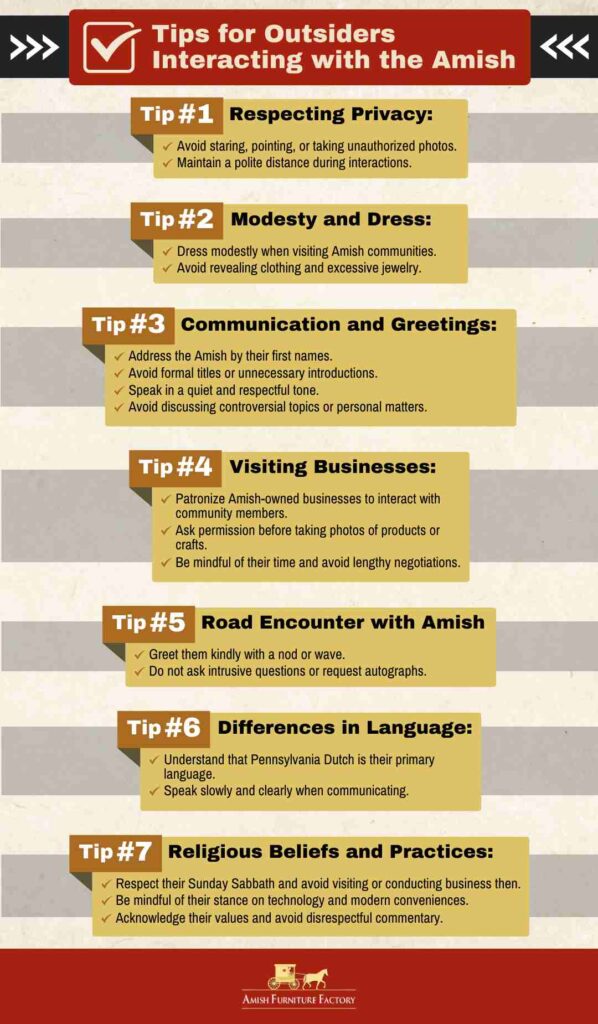
Beyond the Do’s and Don’ts of Amish Etiquette
While Amish customs may seem peculiar to us outsiders, it’s important to approach them with respect and understanding.
Remember, the Amish value simplicity and humility above all else, so don’t be surprised if they reject your fancy gadgets or flashy clothing. By adhering to their principles and embracing their way of life, we can truly learn valuable lessons about community, faith, and living in harmony with nature.
So next time you encounter an Amish person, put on your best bonnet and engage in meaningful conversation – who knows what wisdom you might gain!
